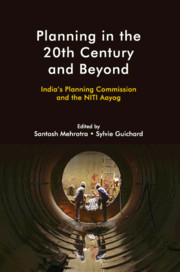Book contents
- Frontmatter
- Contents
- List of Figures
- List of Tables
- List of Abbreviations
- 1 Planning for a 21st Century India
- Part I Origins: Ideas and Ideology
- 2 From Economists to Historians: Studying the Planning Commission, 1950–2014
- 3 The Long Road to Indian Economic Planning (until 1950)
- 4 Ideas and Origins of the Planning Commission in India
- Part II Changes and Continuity: Development and Adaptation of Planning and the Planning Commission
- 5 The Planning Commission and Education
- 6 Addressing Agrarian Distress: Sops versus Development
- 7 Economic Planning after Economic Liberalization: Between Planning Commission and Think Tank NITI, 1991–2015
- 8 Planning Commission: Obiter Dictum
- 9 On a Revived Planning Commission
- Part III Planning Beyond the Planning Commission
- 10 Make in India
- 11 Manufacturing: The Cornerstone of a Planning Strategy for the 21st Century
- 12 Fiscal Planning to Sustain Growth and Poverty Reduction
- 13 Plan, but Do Not Over-plan: Lessons for NITI Aayog
- 14 Why Does India Need a Central Planning Institution in the 21st Century?
- Notes on Contributors
- Index
- References
6 - Addressing Agrarian Distress: Sops versus Development
Published online by Cambridge University Press: 04 April 2020
- Frontmatter
- Contents
- List of Figures
- List of Tables
- List of Abbreviations
- 1 Planning for a 21st Century India
- Part I Origins: Ideas and Ideology
- 2 From Economists to Historians: Studying the Planning Commission, 1950–2014
- 3 The Long Road to Indian Economic Planning (until 1950)
- 4 Ideas and Origins of the Planning Commission in India
- Part II Changes and Continuity: Development and Adaptation of Planning and the Planning Commission
- 5 The Planning Commission and Education
- 6 Addressing Agrarian Distress: Sops versus Development
- 7 Economic Planning after Economic Liberalization: Between Planning Commission and Think Tank NITI, 1991–2015
- 8 Planning Commission: Obiter Dictum
- 9 On a Revived Planning Commission
- Part III Planning Beyond the Planning Commission
- 10 Make in India
- 11 Manufacturing: The Cornerstone of a Planning Strategy for the 21st Century
- 12 Fiscal Planning to Sustain Growth and Poverty Reduction
- 13 Plan, but Do Not Over-plan: Lessons for NITI Aayog
- 14 Why Does India Need a Central Planning Institution in the 21st Century?
- Notes on Contributors
- Index
- References
Summary
In the post-independence period, India is facing its second major challenge in agriculture. The first major challenge was experienced during mid-1960s when, prior to the green revolution, output was rising slowly, the per capita foodgrain production dropped to a very low level (150 kilograms), while population growth was on a rising trajectory, and the country faced serious shortage of staple food. This had left the country hugely dependent on food imports and food aid. The shortage of food was so severe that the then prime minister Lal Bahadur Shastri had to appeal to the countrymen to observe fast and miss one meal once a week to cope with the shortage of food. The country then decided to adopt and promote new high-yielding varieties (HYVs) of wheat and paddy, known as green revolution technology, which were much more responsive to fertilizers and other inputs as compared to the traditional varieties. The adoption of green revolution technology produced quick results. Despite its adoption in a limited area, India was able to emerge out of the crisis situation of shortage of staple food in less than a decade. Since the green revolution, the growth rate in production of all types of food groups except pulses remained higher than the population growth in most of the period. During the last half century (1965 to 2015), the total food production, including cereals, pulses, oilseeds, vegetable, fruits, and livestock products, rose 3.7 times while population rose 2.55 times. The net result has been a 45 per cent increase in per person food production, which has made India not only food self-sufficient at an aggregate level but a net food exporting country. This increase in per capita food production is clearly visible in per capita intake of fruits, vegetables, meat, eggs, milk, fish, and sugar. However, per capita intake of cereals showed a decline because of dietary preferences, not because of availability. The effect of this change in consumption basket on dietary energy intake is not significant.
While India was improving food security and leaving behind the era of food shortage, another crisis started building gradually in the form of agrarian dissatisfaction. Some scholars term it as agrarian distress. Farmers’ dissatisfaction turned serious during the early 1990s, though it started developing a few years ago.
- Type
- Chapter
- Information
- Planning in the 20th Century and BeyondIndia's Planning Commission and the NITI Aayog, pp. 110 - 131Publisher: Cambridge University PressPrint publication year: 2020



